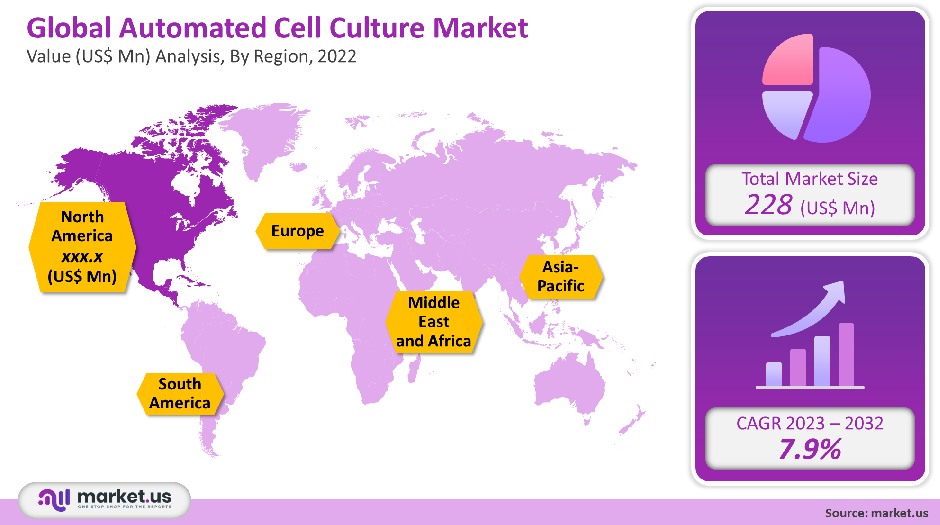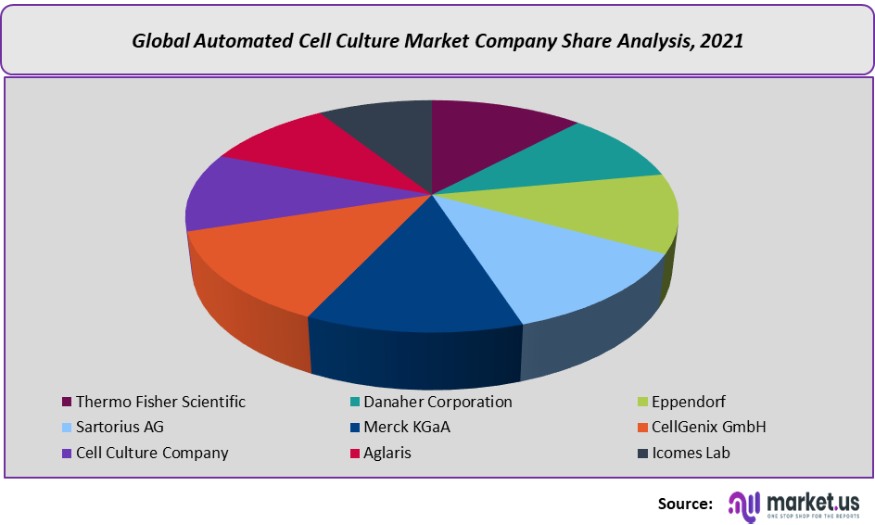Automated Cell Culture Market By Type (Modular Automation, Whole Lab Automation), By Product (Consumables, Vessels), By Application(Biopharmaceutical Production, Diagnostics, Other Applications), and by Region and Companies Industry Segment Outlook, Market Assessment, Competition Scenario, Trends and Forecast 2022-2032.
- Published date: Feb 2022
- Report ID: 83618
- Number of Pages: 332
- Format:
- keyboard_arrow_up
Automated Cell Culture Market Overview:
The Automated Cell Culture Market is projected to reach a valuation of USD 526.22 Mn by 2032 at a CAGR of 7.9%, from USD 228 Mn in 2021.
A cell is the basic unit of life, and a cell line is a culture that has grown from a single cell to many cells. Cell culture is the process of growing cells in a controlled setting, usually outside of their native habitat. Following the isolation of the cells of interest from living tissue, they can then be maintained under carefully regulated conditions. These parameters differ depending on the cell type, but they usually include a suitable vessel and a substrate or medium that provides the necessary nutrients.
For cell lines, there are two types of growth sources: mammalian cells and non-mammalian cells. Cell culture is crucial in cellular and molecular biology because it provides the most refined platform to study cell physiology and biochemistry in their natural state. Primary cell culture, secondary cell culture, and cell culture are the three primary forms of cell culture.
Automated cell culture systems can dilute samples, grow cultures in liquid with constant swirling, plating cultures, or place cultures in wells. Automated cell culture systems are instruments that perform tasks necessary to mechanically develop and maintain a cell culture. An automated cell culture system can help develop cell cultures while saving time on labor while reducing errors in any lab that works with cell biology, cell signaling, protein expression, or drug discovery.
Diluting samples, growing cultures in liquid with constant swirling, plating cultures, and inserting cultures in wells are all possible with automated cell culture systems. A lab’s requirements must be taken into consideration when selecting an automated cell culture system.
Some methods can culture multiple cell lines at once or can do vast volumes of one cell line. Others automated cell culture systems can adjust the temperature by heating, chilling, or both, and some have onboard microscopes and cameras to track cells.

Segmentation of the Global Automated Cell Culture Market
By Type
- Modular Automation
- Whole Lab Automation
By Product
- Consumables
- Vessels
By Application
- Biopharmaceutical Production
- Diagnostics
- Gene Therapy
- Drug Screening and Development
- Toxicity Testing
- Stem Cell Research
- Tissue Engineering & Regenerative Medicine
By Region
- North America
- Europe
- Asia-Pacific
- South America
- The Middle East and Africa
Market Dynamics
Growing awareness concerning the benefits of cell culture-based vaccines and the consequent development of novel vaccines and biopharmaceuticals are expected to boost the global automated cell culture market’s revenue growth prospects. Novel vaccines and biopharmaceuticals contain all the nutrients cells require and maintain the physiochemical environment such as pH, osmolality, and temperature, suitable for a cell’s culture.
An increasing number of research & development activities being carried out globally is another significant factor that is expected to supplement the global automated cell culture market’s further augmentation. The investment-related capital needed for the set-up of cultural facilities is high.
Furthermore, there are high chances of cross-contamination of different types of cells, leading to genetic variations in the cell population. This may affect heterogeneity, in turn impacting the capability of distinguishing a cell population, and thus could act as a restraining factor that could negatively influence the economic growth of the global automated cell culture market.
A spike in the number of tests being done regularly due to the prevalence of infectious diseases is expected to lead to an increase in the demand for testing and research equipment. As automated cell culture systems are time and cost-effective, the results can be drawn instantly. This element has subsequently led to an increase in the global automated cell culture equipment market’s size.
Competitive Landscape
- Thermo Fisher Scientific
- Danaher Corporation
- Eppendorf
- Sartorius AG
- Merck KGaA
- CellGenix GmbH
- Cell Culture Company
- Aglaris
- Icomes Lab
- Lonza
- Kawasaki
- Biospherix

Recent Developments in this Industry:
- In October 2020, Eppendorf (Germany) launched Refrigerated Centrifuge 5425 R
- In September 2020, Thermo Fisher Scientific (US) opened a new bioprocessing collaboration center in St. Louis, Missouri, US.
- In September 2020, Cytiva plans to increase its manufacturing capacity with an investment of USD$500 million.
- In April 2020, Danaher Corporation completed the acquisition of GE Healthcare’s biopharma business. Under Danaher’s ownership, the business will be renamed Cytiva.
For the XXXXX Market research study, the following years have been considered to estimate the market size:
Attribute Report Details Historical Years
2016-2020
Base Year
2021
Estimated Year
2022
Short Term Projection Year
2028
Projected Year
2023
Long Term Projection Year
2032
Report Coverage
Competitive Landscape, Revenue analysis, Company Share Analysis, Manufacturers Analysis, Volume by Manufacturers, Key Segments, Key company analysis, Market Trends, Distribution Channel, Market Dynamics, COVID-19 Impact Analysis, strategy for existing players to grab maximum market share, and more.
Regional Scope
North America, Europe, Asia-Pacific, South America, Middle East & Africa
Country Scope
United States, Canada and Mexico, Germany, France, UK, Russia and Italy, China, Japan, Korea, India and Southeast Asia, Brazil, Argentina, Colombia etc.Saudi Arabia, UAE, Egypt, Nigeria and South Africa
![Automated Cell Culture Market Automated Cell Culture Market]() Automated Cell Culture MarketPublished date: Feb 2022add_shopping_cartBuy Now get_appDownload Sample
Automated Cell Culture MarketPublished date: Feb 2022add_shopping_cartBuy Now get_appDownload Sample - Thermo Fisher Scientific Company Profile
- Danaher Corporation Company Profile
- Eppendorf
- Sartorius AG
- Merck KGaA Company Profile
- CellGenix GmbH
- Cell Culture Company
- Aglaris
- Icomes Lab
- Lonza Group AG Company Profile
- Kawasaki Heavy Industries, Ltd. Company Profile
- Biospherix
- settingsSettings
Our Clients
|
Single User
$5,999
$2,999
USD / per unit
save 50% |
Multi User
$7,999
$3,499
USD / per unit
save 55% |
Corporate User
$12,999
$4,499
USD / per unit
save 65% | |
|---|---|---|---|
| e-Access | |||
| Data Set (Excel) | |||
| Company Profile Library Access | |||
| Interactive Dashboard | |||
| Free Custumization | No | up to 10 hrs work | up to 30 hrs work |
| Accessibility | 1 User | 2-5 User | Unlimited |
| Analyst Support | up to 20 hrs | up to 40 hrs | up to 50 hrs |
| Benefit | Up to 20% off on next purchase | Up to 25% off on next purchase | Up to 30% off on next purchase |
| Buy Now ($ 2,999) | Buy Now ($ 3,499) | Buy Now ($ 4,499) |








